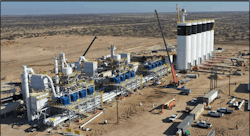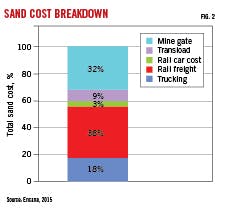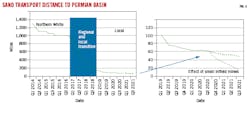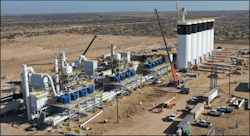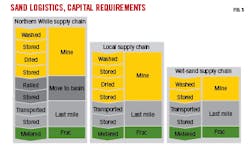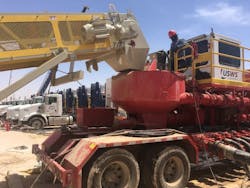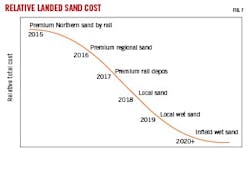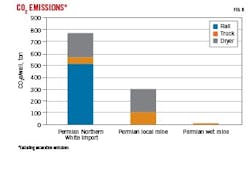Wet sand improves Permian basin supply chain
Ian Wilson
Ovintiv Inc.
Denver
Local in-field sand supplies have decreased fracture treatment costs in the Permian basin. Further cost reductions are achieved by eliminating sand drying, leaving the sand at residual 4-6% water saturation. Wet-sand transfer and metering, however, require specialized equipment to overcome grain-to-grain cohesion.
Wet-sand use removes a large portion of emissions from the unconventional-development supply chain, reducing sand-related emissions by more than 90%. Additionally, damp sand minimizes airborne dust, improving wellsite safety, comfort, and visibility.
Dry sand
The Saint Peter Sandstone formation, running from Minnesota through Wisconsin and Illinois, extending into Arkansas, has historically produced Northern White dry sand for fracture applications. This sand is spherical, pure quartz, strong, and well suited for API’s recommended frac-sand specifications. After placement, the sand provides highly conductive connections between the well and reservoir hydrocarbons that were considered stranded before the shale revolution. As the industry developed tighter resources, proppant volume per well increased while proppant particle size decreased (Fig. 1).1 This reduced fracture conductivity and drove up completion costs due to increased proppant volumes and price inflation.
The Northern White supply chain can be deconstructed into four primary activities: mining, transporting to basin, transporting to wellsite (last mile), and delivery to the fracturing stream. Sand is a low value yet high-volume product for which handling and logistics make up about 70% of total cost (Fig. 2). A modern-day completion often requires 100 rail cars and more than 400 truckloads to deliver sand to a single well. As traditional mines started to expand to feed growing demand, others started exploring local supplies to cut logistical costs and complexity.2
Much of the next wave of alternative sources still required rail to transport the sand to producing basins. Landed costs, however, were cut by reducing the distance travelled.3 These regional sands typically had lower API specifications than Northern White. Infinite-fracture conductivity modelling, however, showed that these lower-conductivity sands had no impact on well performance, and they were quickly adopted.4 The acceptance of these sands spurred the search for even closer supplies.
Several sand sources were identified and developed close enough to fields to bypass rail. Local sand sources quickly took market share from both Northern White and regional sand suppliers, completing a cycle which drove out more than 90% of the required transportation distance, about 40% of total sand cost (Fig. 3).
Wet sand
By removing several layers of logistics, the local sand evolution brought sand producers closer to their end users (Fig. 4), allowing fresh scrutiny of the way things were done. Ovintiv began a study to understand, test, support, and implement regional and local sands coming into the market. A tour of existing Northern White mines showed they were analogous to refineries, with intense capitalization in equipment to produce tight specifications and enable rapid shipping around North America. The processes included excavation, crushing, washing, decanting, drying, screening, storage, and rail car loading. Sand was sized at the wash plant to reduce the burden at the dry plant. An open question was whether a drying plant was required at a particular Permian site when the wash plant alone got sand close to required specifications.
There are several reasons white sand is dried. After the sand is washed to remove impurities, it is stacked in a large pile to decant. Moisture quickly drops and plateaus at 4-6% weight-moisture content. This extra water weight significantly adds to transport costs, particularly on trips longer than 1,000 miles. Winter also poses challenges, as damp sand will freeze into solid chunks, making unloading rail cars and trucks nearly impossible.
In general, damp sand is much harder to handle than dry sand. When dry, sand behaves more like a liquid, easily flowing through tight screens and other openings resulting in tighter specifications and more predictable flow rates. When wet, natural cohesion between grains and other surfaces makes sand flow unpredictable and more easily fouls screening equipment. Transferring damp sand from one mode of storage to another is more difficult, and traditional ways of accurately metering sand into the fracturing stream are no longer sufficient. Fracturing requires sand rates as high as 20,000 lb/min and cannot afford to be disrupted due to sticky sand. Given these disadvantages, wet sand would appear to be a non-starter.
Wet sand’s advantages become clearer, however, when studying potential benefits and pitfalls of skipping the dry-plant processes. Overall costs and environmental, health, and safety (EHS) benefits were measured against operational complexities introduced with wet sand. Benefits included:
- Lower capital costs. By avoiding drying, vertical storage, and conveyance equipment costs, a new sand plant can be deployed with about 50% of the capital required in a traditional setup.
- Lower operational costs. Personnel, equipment maintenance, and fuel for drying can be reduced or eliminated.
- Reduced regulatory complexity. Time and cost of routing gas or electric lines to the dryer and necessary air-quality permits can be eliminated.
- Enhanced plant storage efficiency. Mine throughput is no longer restricted by drying process throughput or vertical storage capacity. Large, low-cost decanting piles become the storage solution, expanding available storage by a multiple of 20 over silos at 1/20th the cost.
- Lower energy input and emissions. The mine’s finished product bypasses the energy intensive drying process.
- Reduced fugitive silica dust in air. Moisture keeps silica dust adhered to other particles, reducing hazardous airborne dust in workplace environment and communities.
Fig. 5 captures some of the scale of savings using local wet sand compared with traditional Northern White or local dry sand. Problems encountered when incorporating wet sand in the supply chain include:
- Handling. Traditional equipment is inadequate to transport, handle, and meter sand at sufficient rates and frequency.
- Screening. Traditional screens cannot be used to size sand and protect against unwanted debris.
- Increased haul weight. The cost of transporting the extra moisture is proportional to the moisture content. Increased costs are greatly reduced when the sand source is less than 75 miles from the destination.
Qualification
While assessing the operational feasibility of substituting wet sand for dry, an effort was made to find solutions using as much existing oilfield equipment and infrastructure as possible. Ideas on how to load, unload, and accurately deliver sand to the fracturing equipment had to be tested and efficiency measured.
Initial tests loaded and unloaded trucking equipment at local mines. Based on the results, non-stick surfaces and vibrators were fitted to modular box containers, similar to tools used in the industrial minerals sector to deliver and store sand at well sites. An acceptable vibratory solution was found and the goal of unloading sand at a minimum of 20,000 lb/min was achieved.
After quickly verifying that traditional blender augers could not be used to lift and deliver sand accurately or consistently to the open tub, augers were substituted with a railcar transloader belt. The belt chute was positioned over the blender and successfully conveyed damp sand from the box container into the open tub. Sand was pumped back to a settling pond at a controlled rate. The tests proved that wet sand could be accurately transported with modifications to existing equipment.
Equipment
By working closely with PropX, a sand storage equipment provider, as well as other mining equipment experts, the feasibility testing results were converted to a suite of wellsite equipment capable of wet-sand delivery. Six key pieces of equipment were modified to eliminate the drying process. These included:
- A screening-loading conveyor at the loading site.
- A container which can be quickly loaded and unloaded with wet sand.
- A transfer conveyor at the wellsite that can accept wet sand from containers and transfer it to a temporary hopper.
- A metering conveyor that receives data-van input, puts out a defined sand volume to match job design, and delivers that volume directly to the blender tub.
- A blender with open access to the blender tub.
- An in-line rock catcher screen.
Screening-loading conveyor
Modern completions require proppant delivery as much as 12 million lb/day. Some existing infrastructure will not work with wet sand due to sand bridging across small openings. Special selections of screens and hoppers are required to keep up with demand.
While dry sand can be screened all the way down to fine mesh sizes, damp sand can only be screened to a ¼ in. opening on the more common aggregate vibrating screens. Further reductions to 3/16 in. are possible with high-frequency vibrating equipment. This unit generally includes a large hopper to receive dry or wet sand from a large front-end loader. The front-end loader feeds the hopper, the hopper processes material through a defined screen size, and the conveyor transfers wet sand into a container.
An additional complication is wet sand packing into the container. Sand angle of repose increases from 34° when dry to about 45° when wet. The resulting steeper cone leaves more void space in a container as it reaches the top during loading.
The loading conveyor should be able to transfer 25,000 lb sand in less than 4 min. The loading conveyor may have additional capabilities such as a weigh-in-motion system to accurately load the container. The conveyor’s discharge configuration is important to ensure container-fill capacity is maximized based on state and local road weight restrictions.
The most versatile loading conveyor system moves both vertically and laterally along the length of the trailer. A large container-top opening also plays a key role in loading-efficiency related to time and weight, making it easier to identify and direct the flow towards underfilled sections. Discharge is modified at the container to maximize container loading volume.
Containers
Modifications are made at the top of the container. Due to higher wet-sand angle of repose, larger openings across the top of the container provide optimum loading-conveyor discharge positioning for maximum packing. This modification does not impact the structural integrity of a container built for oil and gas operations. To speed the process, loading-conveyor discharge should be positioned above the center point of the container.
Transfer conveyor
The transfer conveyor requires a vibration system. The key challenge was creating a vibration system that provided enough energy at the correct frequency to overcome wet-sand cohesion without impacting operation or the reliability of the conveyor itself. A vibration table and dampening system imparted enough vibrational energy to the container while protecting conveyor components from the same vibrations.
Metering conveyor
The metering conveyor replaces the auguring system on traditional blenders and had to be specially built because no existing piece of oilfield equipment was suitable. The unit has two components: a hopper and conveyance system (Fig. 6). The hopper provides resonance-time between the transfer conveyor and metering conveyor and can function with wet or dry sand. Because of the heterogenous nature of wet-sand unloading, large hopper sizes were important to provide operators sufficient time to react during high-rate jobs.
Wet sand enters the hopper from the transfer conveyor through an open top and exits through a controlled gate that pairs with the metering conveyor. Wet sand then moves from the container, through the transfer conveyor, and discharges into the hopper. The metering portion of the conveyor is a simple belt that includes a unique adjustable gating mechanism which determines sand-ribbon thickness. It also has a weigh-in-motion system to determine delivered sand volume. Software which is compatible with a multitude of frac operation software interacts with data-van inputs to calculate sand demand at a given point in the job. This unit delivers sand up to 8 lb/gal at 100 bbl/min to match transfer conveyor functionality. Moisture content inputs further improve accuracy. When calibrated, the metering conveyor delivers sand within a 2% margin of error, outperforming traditional dry-sand augers.
Service-company blender tub
Discharge from the metering conveyor is on a 36-in. wide belt over an enclosed head pulley with limited throw. To discharge into any service provider blender tub, the discharge needs access to a ~36-in. diameter space directly above the blender tub. For blenders that operate using sand augers, the sand auger assembly should be removed.
The system adds already wet sand to the blender tub, resulting in additional water downstream of the clean-rate flow meter and upstream of the slurry-rate flow meter. Most blending systems run algorithms based on slurry rate and densometer readings to determine sand-mass entering the well. When adding wet sand to the blender tub, the clean-rate flow meter will reduce slightly as it compensates for the additional water. This method does not impact densometer sand concentration readings or total sand volumes calculated by data-van software.
In-line rock catcher screen
Without the ability to screen tighter than 3/16 in. immediately before loading, additional pump protection become critical. In-line screen analysis showed an oversize protection drop from about 99.99999% to 99.99990% when moving from dry to wet sand. The seemingly small change is equivalent to increasing impurities from less than 1 lb/day of material to about 8 lb/day when pumping 8 million lb of proppant. While the makeup of impurities typically does not change pump performance, small gaps in quality control at the mine are harder to catch. These impurities cause inefficiencies at the wellsite, ranging from time spent clearing rock catchers to increased pump-seat and valve maintenance if screens are bypassed. Different screen types have been tried downstream of the blender discharge pump with varying levels of efficiency. Balancing material cost, cleaning time, and material longevity is key when determining the solution.
Cost savings
By avoiding the cost of purchasing and installing driers, vertical storage, and conveyance equipment, a new sand plant without drying capability can be deployed with about 50% the capital required by a traditional setup. Reducing sand cost amortization and depreciation can secure capital to develop smaller reserves close to the sand site that might otherwise be uneconomic. These small-but-nearby operations can greatly reduce well costs by carving out even more logistical expenses, often reducing last-mile costs by 50%.
Cost savings associated with wet sand have negligible effect on proppant performance. Wet plant processes are tuned to provide API specifications like those from a dry plant, and there have been no observed effects on production.5
Personnel, equipment maintenance, and fuel for drying can be reduced or eliminated entirely, permanently lowering the required price at the mine gate. Relative to Northern White imports, in-field wet sand mines remove about 66% of the total sand cost, permanently reducing per well costs by more than $800,000 over the last 5 years (Fig. 7).
The time and cost burden of routing gas or electric lines to the dryer and obtaining necessary air quality permits can be reduced or eliminated. This can greatly reduce project time depending on local regulatory regimes and utility lead times.
Mine throughput is no longer restricted by drying process throughput or vertical storage capacity. For example, a 5-million ton/yr mine with six 5,000-ton silos can hold about 2 days dry-sand production, whereas a small 700,000-ton wet-sand mine can easily store 100,000 tons of finished wet product cheaply in a semi-circular shaped pile, storing about 2 months of production with little more than a conveyor stacker. This change in operating philosophy moves the supply away from a just-in-time inventory model, giving the supplier and end-user ample opportunity to adjust to planned and unplanned supply and demand volatility.
The mine’s finished product bypasses the energy intensive drying process, removing a large portion of emissions from the unconventional development supply chain. When compared with importing Northern White sand, an in-field local sand mine reduces sand-related emissions by more than 90%, or 700 tons of CO2e/well.
Fugitive silica dust has been identified as an occupational health hazard and is regulated by the Occupational Safety and Health Administration in the US. In the summer of 2021, operators will need engineering controls to lower permissible exposure limits of silica dust on all wellsites to 50 µg/cu m/ 8 hr, with an action limit (AL) of 25 µg/cu m/8 hr.
Moisture in damp sand keeps silica dust adhered to other particles, reducing hazardous airborne dust in the workplace and surrounding communities. Ovintiv has sampled more than 30 sensors placed on personnel and in surrounding areas while using wet sand, which was found to be consistently under AL. The data suggests that dust respirators may not be required, improving the comfort and vision of personnel on the wellsite.
References
- IHS Markit, FracIQ 16Q4 Release, Oct. 11, 2016.
- Wilson, I., “Understanding Unconventional Upstream Supply Chain Performance Drivers,” PETE 692, Master’s thesis, Texas A&M, Apr. 10, 2017.
- Dorfman, B., Oehler, M., Fisher, K., and Wilson, I., “Can Wet Sand be Used for more than Building Sand Castles on the Beach,” SPE-199975-MS, SPE Canada Unconventional Resources Conference, Virtual, Sept. 29-Oct. 2, 2020.
- Melcher, H., Mayerhofer, M., Agarwal, K., Lolon, E., Oduba, O., Murphy, J., Ellis, R., Fiscus, K., Shelley, R., and Weijers, L., “Shale-Oil-Fracturing Designs Move to Just-Good-Enough Proppant Economics with Regional Sand,” SPE 199751, SPE Drilling and Completions, Vol. 35, No. 4, 2020, pp. 628-42.
- Jacobs, T., “How Wet-Sand Completions Became Key to Chesapeake’s Low-Cost Future,” Journal of Petroleum Technology, Vol. 73, No. 4, Apr. 1, 2021.
Author
Ian Wilson ([email protected]) is manager of commodities and logistics at Ovintiv, formerly EnCana Corp. Before joining the company in 2014, he spent 6 years at Schlumberger in a variety of roles in drilling and completion segments. He has a BS (2007) in civil engineering from Colorado State University and an ME (2016) in petroleum engineering from Texas A&M University.
